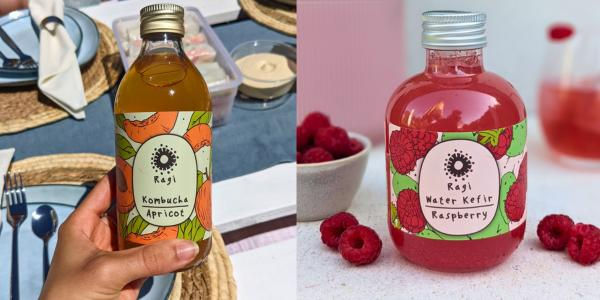Fermentation is a fascinating process used for centuries to preserve and transform food. It involves the action of beneficial bacteria, yeasts, or molds that break down sugars and carbohydrates in the food, unlocking new flavours, textures, and beneficial compounds. Let's dive into the world of fermented foods and explore some different types available, along with their unique flavours and characteristics.
Sauerkraut:
Sauerkraut is a classic lacto-fermented food made from shredded cabbage (usually white cabbage) that has been salted and left to ferment. The cabbage releases liquid, creating its own brining solution. The fermentation process gives it a tangy and slightly sour flavour. It's often used as a topping or side dish and it can contain good gut bacteria, when it's not pasteurized.
Kimchi:
Originating from Korea, kimchi is a spicy lacto-fermented vegetable dish, typically made from nappa cabbage or radishes, and a blend of seasonings such as chilli powder, garlic, and ginger. Kimchi follows the same principle as sauerkraut: Lactic acid bacteria are present in the raw cabbage. When submerged in a salty brine, these bacteria convert the sugars into lactic acid, which is a natural preservative.
Kimchi offers a vibrant combination of spicy, sour, and umami flavours. Kimchi is a functional food and a versatile ingredient in various dishes. In Korea, they usually eat it as a side dish or mixed with rice.

Kombucha:
Kombucha is a popular fermented drink made from sweetened tea that undergoes fermentation by a symbiotic culture of bacteria and yeast (SCOBY). Acetic Acid Bacteria usually dominate this bacterial community in kombucha. It results in a fizzy, tangy, and slightly sweet beverage with a wide range of flavours, depending on the ingredients used during fermentation. Common flavours include fruity, floral, or herbal variations. You can enjoy kombucha on its own, in a cocktail, or add it to your smoothies and vinaigrettes.
Water Kefir:
Water kefir is a non-dairy fermented beverage made by fermenting sugar water with water kefir grains. These grains are a combination of bacteria and yeast cultures (different from the milk kefir) that transform the sugars into organic acids, carbonation, and other beneficial compounds. Water kefir has a mild and slightly sweet taste, often with fruity or floral undertones. It is a great alternative to milk-based kefir.

Milk Kefir:
Milk kefir is a fermented drink that is made by adding milk kefir grains to milk. Kefir grains are a combination of bacteria and yeast cultures that ferment the sugars in milk, resulting in a tangy and slightly effervescent beverage. Usually, it's made with cows' or goat's milk, but it can also be made with fatty plant-based milk like coconut, cashew or almond. Milk kefir has a creamy texture and a tart, refreshing flavour.
Yoghurt:
Yoghurt is a well-known fermented product made by adding specific bacterial cultures to milk. The fermentation process converts lactose (milk sugar) into lactic acid, creating a creamy and tangy product. Nowadays you can find great yoghurts made of cashews, soy, or even chickpeas that are as nutritious (sometimes even more) than animal milk yoghurts. Yoghurt comes in various flavours and can be enjoyed plain or with added fruits, nuts, or natural sweeteners.

Miso:
Miso is a traditional Japanese fermented paste made from soybeans, rice or barley, salt, and a mold culture called koji. It has a rich, savoury, and slightly salty taste. Miso is commonly used as a base for soups, marinades, and sauces, adding depth and complexity to dishes.
Tempeh:
Tempeh is a popular plant-based protein food made from fermented beans (usually soy), inoculated with a mold of the genus Rhizopus. It has a firm texture and a nutty, earthy flavour. Tempeh is often used as a meat substitute in various dishes and provides a range of nutrients, including protein, and fibre.

Fermented Pickles:
Pickles are cucumbers or other vegetables that have been submerged in a brine solution and left to ferment. This process results in pickles with a tangy, sour, and often crunchy texture. Fermented pickles offer a unique flavour profile compared to vinegar-based pickles.
Vinegar:
Vinegar is a fermented liquid that is commonly used in cooking, pickling, and as a condiment. It is made by fermenting the sugars present in various food sources, such as fruits, grains, or wine, using specific strains of bacteria. The fermentation process converts the sugars into acetic acid, giving vinegar its distinctive tangy flavour. There are different types of vinegar available, such as apple cider vinegar, balsamic vinegar, rice vinegar, and more, each with its own unique flavour profile and culinary uses.

The world of fermented foods is vast and diverse, offering a wide range of flavours and textures. From sauerkraut to kombucha, yoghurt to miso, and many more, each fermented food has distinct characteristics and properties. .
Incorporating various fermented foods into your diet not only adds depth and complexity to your meals but also introduces beneficial gut bacteria. Explore this fascinating world of flavours and experiment with different fermented foods to find your favourites!
You can find some of these amazing fermented products in our shop

Comments